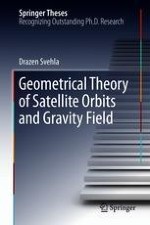To use the dynamics of GPS satellites to complement geometrical Earth rotation and orientation parameters from VLBI has always been a challenge. Geometric VLBI differs from other space geodesy techniques, such as GNSS, SLR and DORIS, in that it does not rely on satellite dynamics to estimate terrestrial reference frame parameters. Here we present a geometrical approach that combines dynamic and geometric variations in the Earth’s rotation with temporal gravity field variations. We demonstrate that this novel approach provides a new insight into the Earth’s interior, especially into processes and dynamics associated with the Earth’s fluid outer core and the great earthquakes over the last 10 and 100 years. Firstly, we demonstrate that by combining two LAGEOS satellites in low MEO orbit we can remove errors in secular orbit perturbations stemming from low zonal harmonics (
J2) and give new insights into the Earth’s rotation and nutation rates. Nutation rates were first estimated from GPS data including orbit determination of GPS satellites (Rothacher et al. 1999). Here we extend the theoretical model of nutation rates and show how, with the nodal separation close to 180° of the two LAGEOS satellites, common orbital errors in terms of nodal and apsidal orbit precession are eliminated. This approach based on celestial mechanics opens up the possibility of using satellite dynamics to determine rates of nutation and variations in length-of-day (
LOD) very accurately and correlate them against the variations in the temporal gravity field (errors in
J2 are eliminated). This then leads us to the unexplained rate of variations in dynamical
LOD estimated from GPS/LAGEOS (orbits driven by Earth’s gravity) and from geometrical
LOD from VLBI (external measure of Earth’s orientation). We show how the rotation of spherical harmonics can explain this unresolved effect since rotation of the tri-axial Earth ellipsoid is the real physical phenomenon measured by gravity field missions as well as by SLR to LAGEOS satellites. We show how the geometrical rotation of spherical harmonics is equivalent to temporal gravity field variations and in the case of second degree harmonics is directly proportional to the rate of variations in
LOD. This was presented for the first time in Švehla (
2008). The conventional IERS mean pole model is in very good agreement with the terrestrial pole of the GRACE monthly gravity field models (derived from
\( \bar{C}_{21} \)̄̄ and
\( \bar{S}_{21} \) gravity field coefficients). We show that temporal variations in the orientation of the tri-axial Earth ellipsoid (sectorials) are taking place along the equatorial plane, i.e., sharing the same axis of rotation within <0.02 arcsec w.r.t. the IERS mean pole model. This dynamic of the tri-axial Earth ellipsoid is very highly correlated with the major earthquakes over the last 10 (GRACE mission) and 100 years. Recently, Holme and de Viron (
2013) showed that variations in the Earth’s rotation that occur with a 5.9-year cycle are probably related to motions within the Earth’s fluid outer core (contemporaneous with geomagnetic jerks). Here we show that temporal gravity field variations in the second degree harmonics, represented by a rotation of the tri-axial Earth ellipsoid, most likely have the definitely same or a similar origin. The idea to study the Earth’s orientation is further extended with a highly elliptical orbit as proposed for the Space-Time Explorer (STE-QUEST) mission in the ESA Cosmic Vision Programme. We discuss the potential of tracking the STE-QUEST satellite in a highly elliptical orbit with VLBI, especially during long apogee dwells, against extragalactic radio sources, thus, combining a geometrical celestial VLBI frame and a terrestrial reference frame. We show how a highly elliptical orbit can be considered as a sensor for Earth rotation, for low-order spherical harmonics coefficients and subsequently for the Earth’s interior dynamics. A satellite dwells for a considerable period of time at the apogee of a highly elliptical orbit, thus it is a perfect target for VLBI to map satellite dynamics against the positions of extra-galactic radio sources. In LEO, a satellite can be observed only for a very short period of time with VLBI and other ground-based techniques. In addition, lunar third-body perturbations are very much uniform along the LEO orbit. Thus, in comparison with HEO, the LEO orbit precesses mainly due to the
J2 coefficient of the Earth’s gravity field.
